Like most storied places around the world, much of today’s Bali is a modern variation on the romanticised images of yesterday. But during Galungan, the quintessential Balinese traditional ceremony, Bali’s roads are arched with enchanting reminders of its ancient past. These arches, made of curved and decorated bamboo poles, are penjor. The archetypal penjor are those created for Galungan which occurs every 210 days.
The beginnings of Galungan and its penjor are obscured in the haze of time. The earliest known reference to this ceremony is in an ancient palm leaf manuscript, the Lontar Bali Dwipa, where it says that the very first Galungan was held on the fourth full moon of the year in 882 C.E. While this celebration and its symbols, the penjor, have been adapted to fit today’s world, it is no modern, tourism-directed, creation.
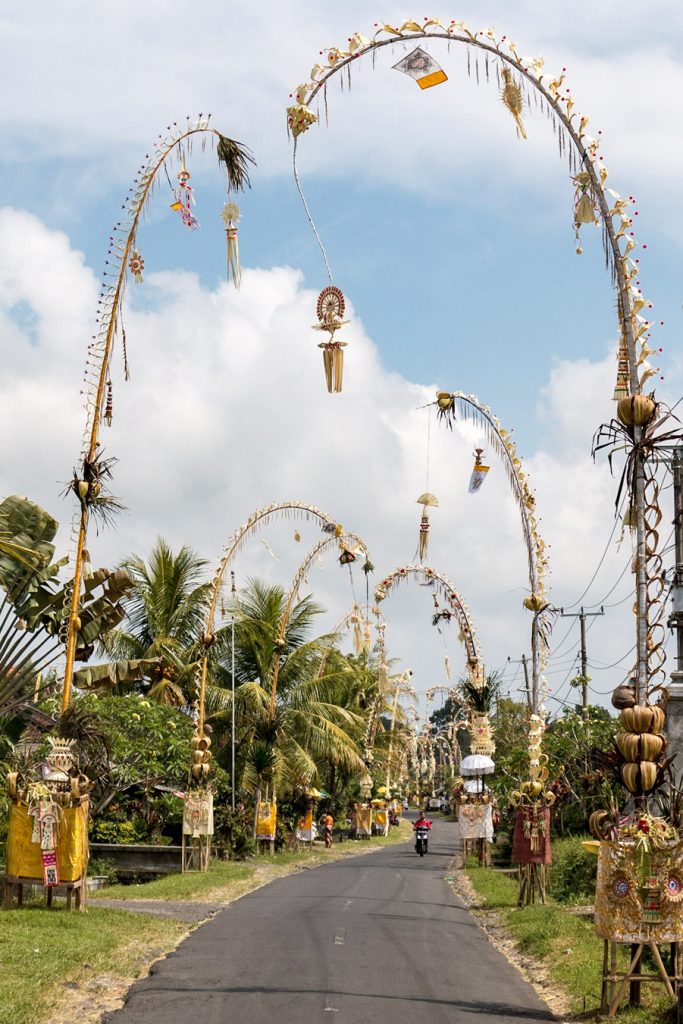
Legend of Galungan
One of the favourite Galungan origin stories has to do with a mighty legendary battle between the forces of good and evil. Fortunately, good won. It is said that the goddess Durga, destroyer of evil, weighed in at the end of the fighting with a plan to assure that humans would always remember the importance of this eternal battle. She commanded the then king of Java, Sri Jaya Kasunu, to establish a cyclical celebration to honour these principles. Today’s Galungan does, in fact, honour her mandate.
But Durga did not stop with the ceremonial command. It seems she also insisted that penjor should be erected by every home to signal the honoured guests – the gods and the ancestors – that they would be honoured wherever a penjor stood.
These ancient edicts are at the heart of Galungan and its penjor even today. It is a time when all Balinese remind themselves of their deep and ancient roots on the island. They strive to find in themselves the ability to tip the balance toward the good, or the dharma, instead of towards evil, or adharma, thus demonstrating their commitment to honour the ancients and the deities.
Tradition has it that the penjor should be posted by every good Balinese family’s door during Galungan. Only one thing is true of all penjor: they are made from a straight and strong bamboo pole – sometimes ten meters tall – symbolising the strength and moral rectitude to which humans aspire.
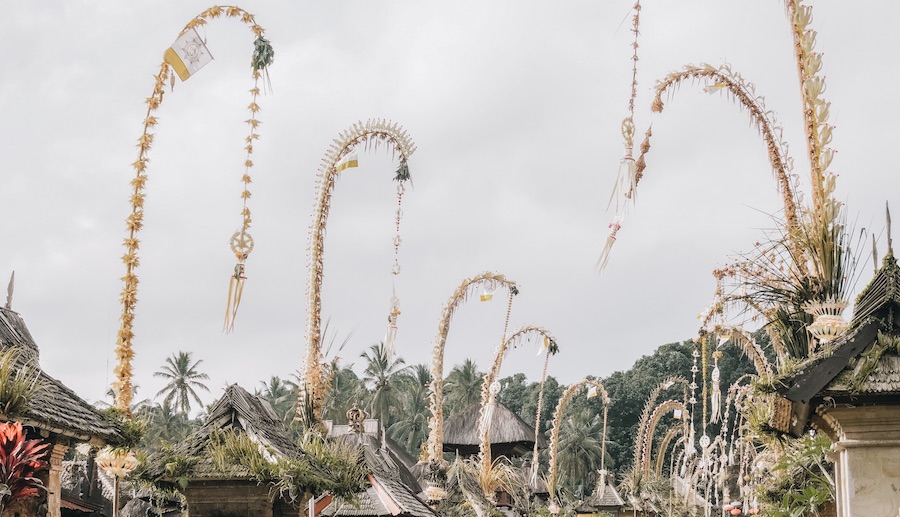
What makes up the penjor
The Galungan penjor are adorned according to specific customs and often embellished by the maker’s own creativity. For days in advance of the ceremonies, the women and girls are busy making and beautifying every item hung on the penjor. Every single thing hanging from or connected to the bamboo symbolises a gift from the land given by the gods and ancestors to the people of Bali.
Some are made of fruits and rice that grow above the ground (the pala gantung), and others that grow in the earth (the pala bungkah) are root vegetables like sweet potatoes and cassava. And each of these elements represents one of the important gods in the Balinese pantheon. The little rice cakes near the crown of the arch, for instance, represent Brahma, the god of creation, while the yellow and white cloth, the kober, symbolises Iswara, the god of the arts and sciences.
The night before Galungan, the men and boys post the penjor in the ground by the entrance to the family home. The next morning, everyone dresses in their finest traditional clothes, collects the offerings they have made to share with others, and gather for prayers at the local temple.
But what are these penjor all about? What do they symbolise?
The meaning of the penjor
“If you ask the nearest Balinese male about the symbolism of penjor, he will probably say, ‘I haven’t got a clue. Ask the women.’ The women will tell you to ask a priest. This is not to say that the men and women of Bali don’t know about penjor. They know very well when and how to make them, how to decorate them, how to make them stand up properly, and why they are important. But they hesitate to explain the symbolism, because the idea that there are correct answers to questions about “religion” in Bali is relatively new.”
So wrote Diana Darling, an American who has lived in and written eloquently about Bali for many years.
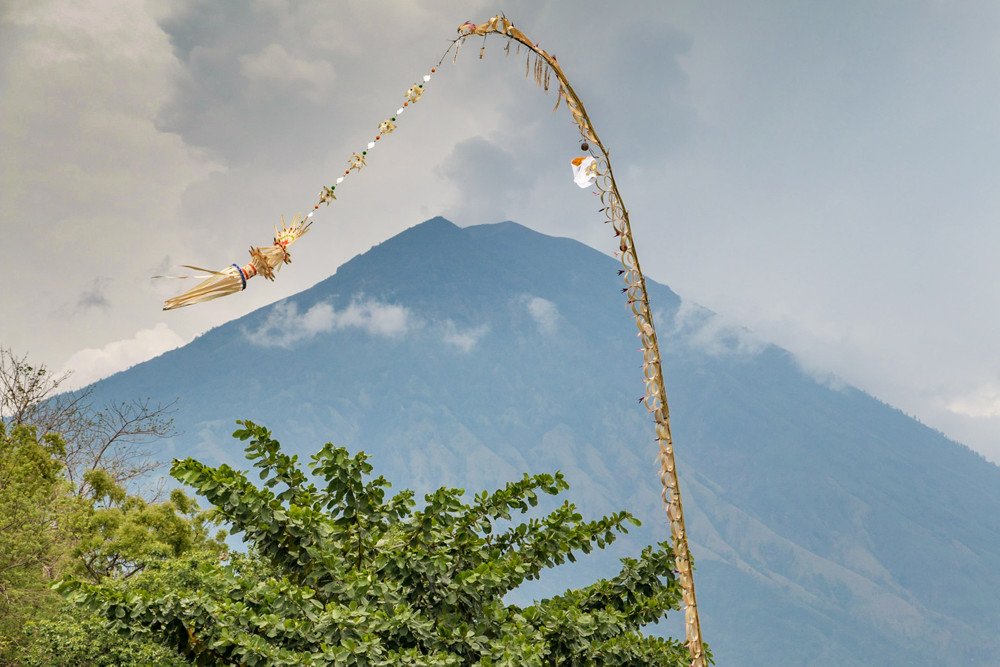
One of the most commonly held beliefs about penjor is that it is a symbol of Gunung Agung, the spiritual mountain in eastern Bali. It is the home of the gods and the ancestors, and is said by many to represent the holy Hindu Mount Mahameru, thus symbolising the entire universe. In this interpretation of the penjor’s meaning, the top is Agung’s peak, and the stem of the penjor, with all of its decorations, represents the rivers flowing down the mountainside, bringing the fullness of the earth to the people below.
Others, however, declare that the penjor represent powerful dragon deities called nagas. The Naga Anantaboga is a symbol of the earthly needs of humankind, while Naga Basuki represents water, prosperity and safety. According to the penjor-as-naga theory, the head of the naga is at the base of the penjor just above the small offering shrine called the Sangah Arda Cahndra. The tail of the naga is the graceful, slender tip of the penjor, and the scales of the dragon’s back are represented by the decorations which curve along the penjor’s back.
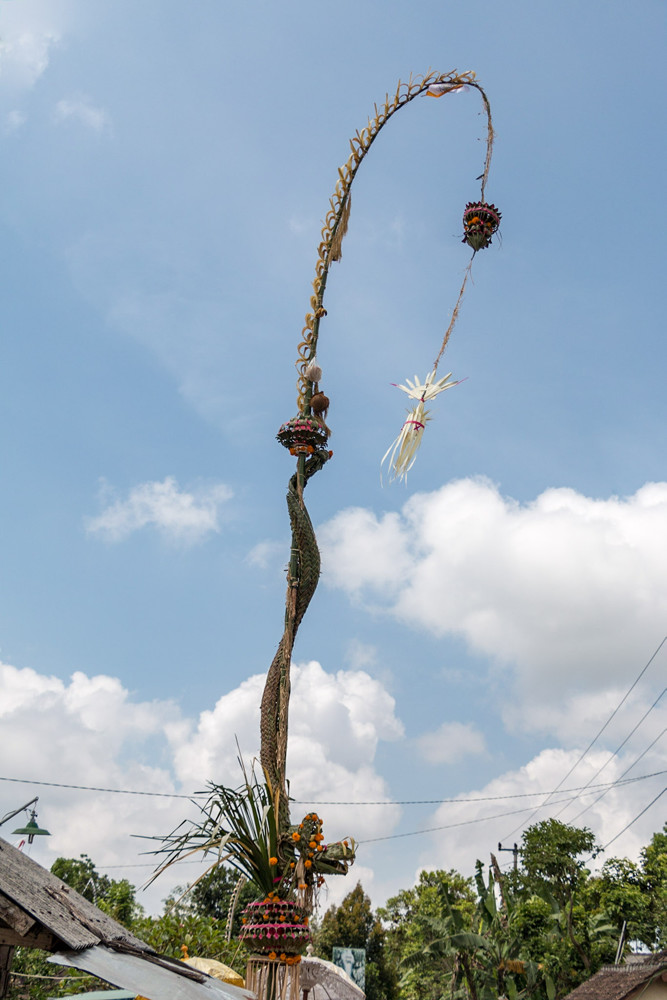
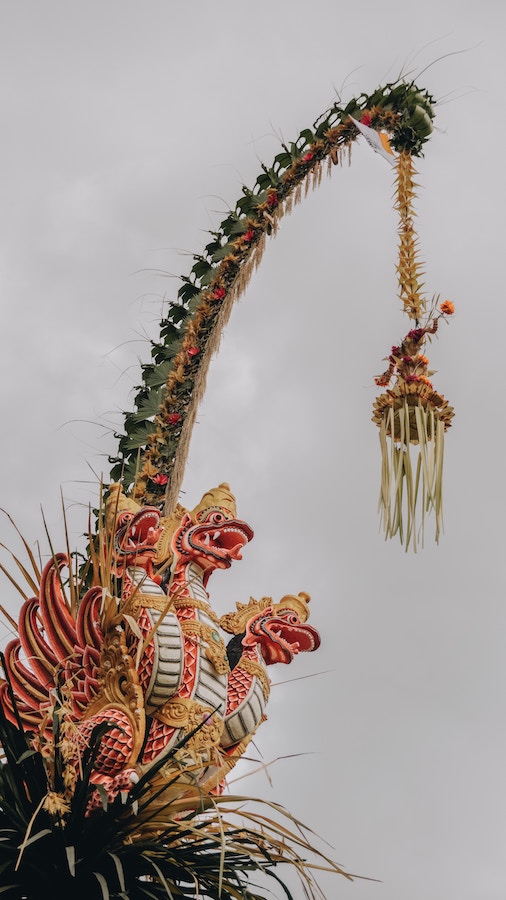
Penjor depicting ‘naga’ (dragon) symbolism
A penjor often is said to hold additional symbolic meanings. For instance, some say that the straight part of the bamboo represents the “good” in humans, while the curve represents the “bad” and thus must be decorated beautifully to compensate. Still others say that the curve of the penjor, with its back straight and its tip looking down to earth, is to remind people that, although they may have achieved a high status in life, they must never, ever, lose sight of their less fortunate fellow humans. The penjor’s downward-facing nature must always remind us of our common roots; we are all born of our mother’s womb, and this common origin confers on us a common responsibility for each other’s welfare.
I Gusti Nyoman Darta explained the significance of the downward curve of the penjor this way: “When I am young and studying, I am always crying ‘oh, I am very clever, very clever,’ but the more I study the more I think: ‘oh I am not so clever now.’ Then I keep what I already learn, and after I am already clever, I just look down like the penjor. When you are already clever enough, you do not speak much, and you are very, very clever. Just like the ripe rice. When it is coming ripe, then the rice in the middle gets heavy, and bends just like penjor.”
Whatever their origins, whatever their meanings, the Galungan penjor will enchant you as you explore Bali’s roads and pathways. If you visit the communities of Ubud or Canggu, you will see some of the most elaborate of all Galungan penjor. And if you travel to some of the more remote villages in the mountains of East Bali, you will come across simpler, more whimsical penjor.
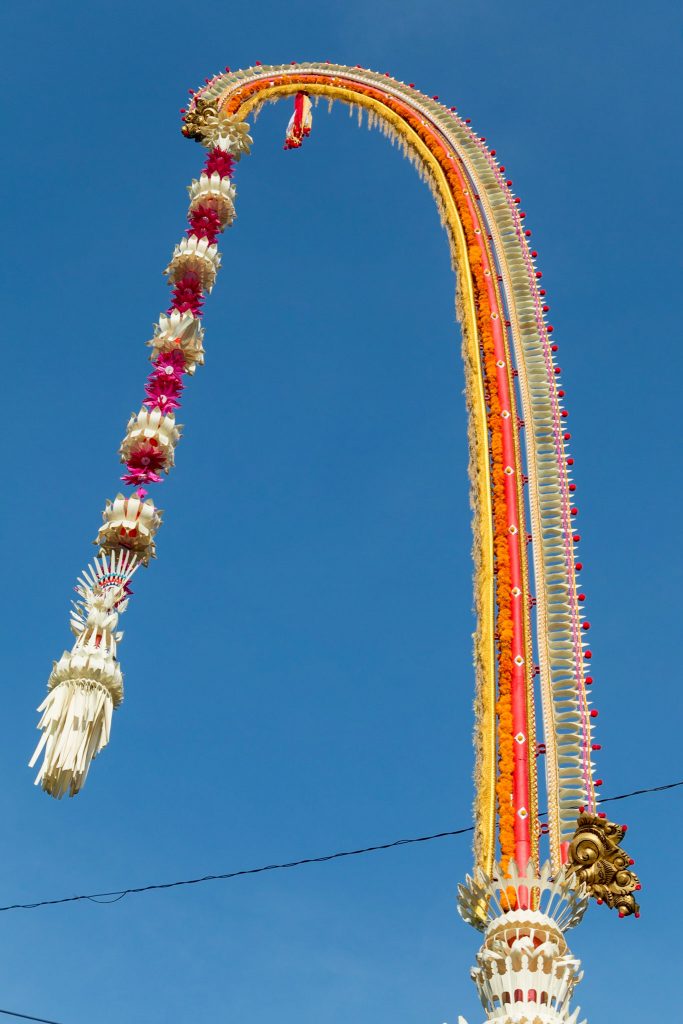
Of course, traditions and ideas established in one village inevitably appeal to penjor creators from another, and styles evolve. Indeed, as one wanders up into the hill villages, the penjor seem to blend East Bali’s whimsy with some of the elements from the more elaborate penjor, and new concepts are born.
You will likely also see penjor which have been created for purposes other than Galungan. Major temple ceremonies always have rows of elaborate penjorto enhance the celebration. The penjor’s eye-catching beauty has also made them popular to announce openings of new businesses and other special events. These penjor are not required to follow the strictures of the Galungan penjorand their designs often reveal the wonderful creativity of the Balinese.
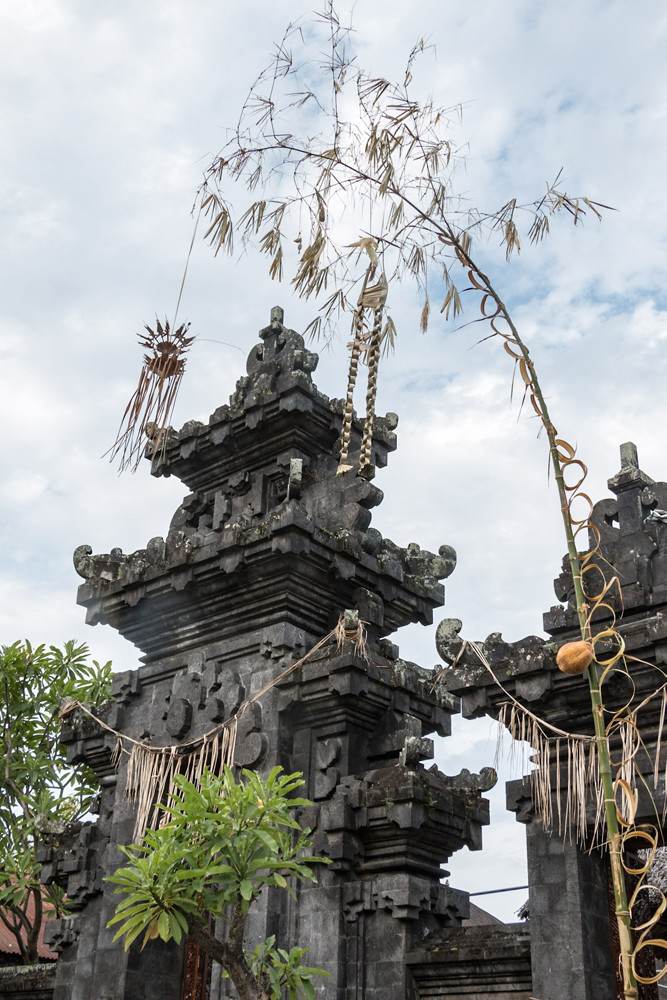
Because so many Balinese today are occupied in jobs away from their homes or even their villages, many no longer have the time to make their own decorations so businesses devoted to making these have sprung up along the roadsides. Many of these “new style” embellishments have bright red pompoms and shimmery bits made of nylon and tinsel. But in the last few years, there has been an effort to return to the older style penjor made exclusively of natural materials.
Just as beauty is in the eye of the beholder, the meaning of the penjor seems to be in the heart and soul of every Balinese – even if that meaning differs from one person to the next. An explanation may be based on deep history, or on village or family stories, or even made up on the spot to appease the inquirer’s curiosity.
But one thing is certain. All penjor – those question marks against the Bali sky – signify a deeply held connection to ancient Bali. Regardless of billboards advertising everything from cigarettes to weddings, regardless of the traffic, regardless of modern commercialism, the old Bali is there – if you look for it.
Written by Susan Ruddy…
…an Alaskan who, over the last fifteen years, has come to think of Indonesia, and especially Bali, as her second home. She recently published ‘Penjor of Bali’, a full book about Bali’s wonderful penjor.






